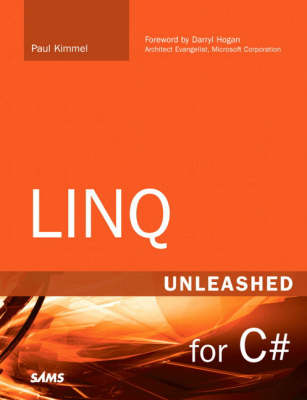Unleashed
2 total works
Microsoft’s highly anticipated LINQ query technology makes it easy to retrieve any information programmatically from any data source, no matter where it comes from or how it’s stored. Using LINQ, developers can query objects, relational databases, XML documents, and ADO.NET datasets--and do it all directly from C# 3.0, leveraging the powerful capabilities of LINQ.
This is a definitive guide to getting real-world results with LINQ, using C# 3.0 and Visual Studio 2008. In LINQ Unleashed, Microsoft MVP Paul Kimmel covers every facet of LINQ programming, showing how LINQ can help you dramatically improve your productivity and build more reliable, maintainable applications.
Kimmel begins by reviewing the state-of-the-art C# programming techniques LINQ uses, including anonymous types, partial methods, and Lambda expressions. Next, using realistic examples and easy-to-adapt sample code, he details the most powerful new LINQ techniques for accessing objects, databases, and XML. You’ll gain a deep and practical understanding of how LINQ works “under the hood”--and learn how to do everything from selecting data through integrating XML with other data models.
- Build efficient LINQ queries to .NET objects, SQL databases, and XML content
- Utilize anonymous types to reduce design time, coding effort, and debugging time
- Automatically generate .NET state machines with the new yield return construct
- Master LINQ query syntax, operators, extension methods, sorting, grouping, aggregate and set operations, and more
- Make the most of select--and use it in the business layer of your n-tier applications
- Query relational data stored in Microsoft SQL Server
- Use nullable types to eliminate unnecessary database access plumbing code
- Use LINQ with ADO.NET 3.0 and Microsoft’s powerful new Entity Framework
- Extract XML data without the hassles or complexity of XPath
- Automatically construct XML from CSV files and other non-XML data
- Query Active Directory by extending LINQ
Introduction 1
Part I Getting Ready for LINQ
1 Programming with Anonymous Types 5
2 Using Compound Type Initialization 29
3 Defining Extension and Partial Methods 61
4 yield return: Using .NET’s State Machine Generator 85
5 Understanding Lambda Expressions and Closures 97
6 Using Standard Query Operators 121
Part II LINQ for Objects
7 Sorting and Grouping Queries 137
8 Using Aggregate Operations 151
9 Performing Set Operations 167
10 Mastering Select and SelectMany 185
11 Joining Query Results 211
12 Querying Outlook and Active Directory 239
Part III LINQ for Data
13 Querying Relational Data with LINQ 265
14 Creating Better Entities and Mapping Inheritance and Aggregation 289
15 Joining Database Tables with LINQ Queries 309
16 Updating Anonymous Relational Data 349
17 Introducing ADO.NET 3.0 and the Entity Framework 383
Part IV LINQ for XML
18 Extracting Data from XML 415
19 Comparing LINQ to XML with Other XML Technologies 437
20 Constructing XML from Non-XML Data 453
21 Emitting XML with the XmlWriter 463
22 Combining XML with Other Data Models 469
23 LINQ to XSD Supports Typed XML Programming 485
Index
This title will include topics such as: multi-tiered application programming, database migration, connecting through programming APIs, scheduling tasks, query optimization, stored procedures, dynamic execution, specialized triggers, replication, SQL Server and XML; Data Transformation Services; security; and Analysis Services.

